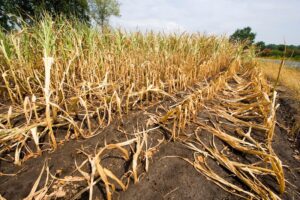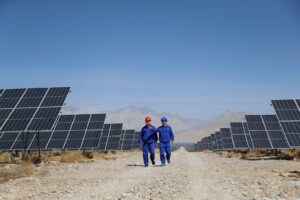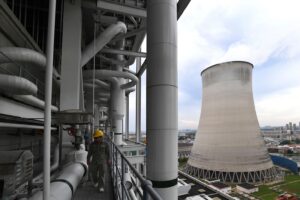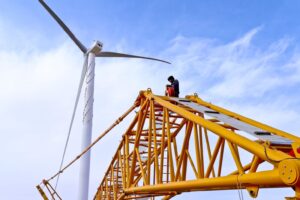Welcome to Carbon Brief’s DeBriefed.
An essential guide to the week’s key developments relating to climate change.
DeBriefed is edited by Daisy Dunne. Please send any tips or feedback to debriefed@carbonbrief.org.
This is an online version of Carbon Brief’s weekly DeBriefed email newsletter. Subscribe for free here.
This week
EU delay
NO NDC: The EU has “failed to agree” on a 2035 target for cutting greenhouse gas emissions in time for a climate event taking place alongside the UN general assembly next week, the Financial Times reported. On 24 September, representatives from more than 100 nations will take part in an event where they will announce or offer more details on their 2035 climate plans, known as “nationally determined contributions” (NDCs), Carbon Brief understands. The FT added that, instead of agreeing to a target, EU member states have signed up to a “statement of intent”, which noted that the bloc would aim to cut emissions somewhere in the range of 66.3% and 72.5% by 2035.
DEADLY: Meanwhile, recent analysis showed that more than 16,000 heat deaths that occurred from June to August this year in the EU can be attributed to fossil-fueled global warming, reported the Guardian. Other recent research covered by Euronews indicated that this summer’s extreme weather events will cost the region about €126bn by 2029.
Australia delivers
NEW TARGET: Australia announced an NDC target of cutting emissions to between 62% and 70% below 2005 levels by 2035, reported the Sydney Morning Herald. This is a jump from the current goal of 43% by 2030, providing a “major challenge to the government and the economy”, given that Australia’s emissions have fallen by just 28% over the past two decades, the newspaper added.
RISING THREATS: The country also published its first national climate risk assessment this week, which concluded that 1.5 million Australians living in coastal areas could be at risk from sea level rise by 2050, BBC News reported. The Guardian added that the report looks at 10 “priority hazards”, including flooding and extreme heat, forecasting a rise of 190% in annual heat-related deaths in Sydney if warming reaches 2C.
Around the world
- FURTHER CHALLENGE: Construction workers announced an indefinite strike in Belém, the Brazilian city hosting COP30 this year, to demand better wages, Folha de São Paulo reported. Reuters reported that the UN had “urge[d] its staff to limit attendance” at COP30, due to concerns over high accommodation costs.
- CUTTING EMISSIONS: India’s power sector CO2 emissions fell by 1% year-on-year in the first half of 2025, only the second such reduction in 50 years, according to new Carbon Brief analysis. The Times of India, Hindustan Times, Reuters and the Indian Express were among those to cover the analysis.
- NEW THREAT: A US Environmental Protection Agency proposal to stop collecting industrial emissions data threatens plans to capture and store CO2, reported the New York Times. Meanwhile, the US National Academies responded to the Trump administration’s misleading claims, with a report calling climate change “beyond scientific dispute”, said Politico.
- ‘REALITY CHECK’: A German government report called for cost efficiency and rapid – but limited – expansion of renewables, Clean Energy Wire reported.
- SECOND CALL: The International Energy Agency reiterated that the world would not need to invest in new oil and gas projects if demand for the fuels fell in line with the 1.5C limit on global warming, Carbon Brief reported.
1%
The percentage of global electricity consumption currently taken up by data centres, according to a new Carbon Brief explainer looking into the climate impact of artificial intelligence.
Latest climate research
- Forest specialist birds, such as the red-cockaded woodpecker and the bearded bellbird, are more diverse and abundant in undisturbed forests | Global Ecology and Biogeography
- Community-led surveillance expands protection, monitoring and defence of larger areas in Amazon forests | Nature Sustainability
- Incorporating aerosols can improve the accuracy of climate attribution studies, since aerosols “strongly influence” local heat extremes | Weather and Climate Extremes
(For more, see Carbon Brief’s in-depth daily summaries of the top climate news stories on Monday, Tuesday, Wednesday, Thursday and Friday.)
Captured

The seventh assessment cycle of the Intergovernmental Panel on Climate Change (IPCC), the world’s leading climate science authority, will include more authors from global south institutions than ever before, according to Carbon Brief analysis. A total of 660 scientists from 90 countries will write the three reports in the next assessment cycle, scheduled for publication in 2029. Some 42% of those authors belong to institutions based in the global south (see chart above), according to Carbon Brief.
Spotlight
Tracing beef in the Brazilian Amazon
In this spotlight, Carbon Brief reports from the Amazonian state of Pará, Brazil, which is implementing new measures to track the impact of beef on deforestation.
The state will host the COP30 climate summit in November.
The Amazonian state of Pará is home to 26m beef cows. The second-largest driver of deforestation in the state is cattle ranching.
Maria Gorete Rios is a small cattle producer in Pará’s municipality of Novo Repartimento. She was the first in Pará to implement individual identification of her cattle.
Of the 78 hectares of her land, 50 hectares are used for cattle and grazing, 10 hectares for her forest reserve and four hectares for producing cocoa and other crops such as cassava, beans, squash and açaí – a fruit native to the Amazon.

Gorete began identifying her cattle thanks to Pará’s first mandatory cattle traceability programme, announced by the state government at COP28 in 2023. The programme seeks to make the cattle supply chain more transparent and to channel incentives for producers to reduce deforestation.

To track her cows, Gorete has given each of them an ear tag tracker, which allows the programme to record which farm each cow was raised on, which slaughterhouse it went to and whether it was raised in illegally deforested areas, Rodrigo Freire, private areas leader for The Nature Conservancy (TNC) in Brazil’s Amazon, explained to Carbon Brief.
To verify that an area was not deforested for cattle production, Brazil’s government has a mandatory registry for rural farmers, which collects information on land use changes over farms, Fábio Medeiros, strategic cattle partnerships director at TNC, told Carbon Brief.
Gorete supports the traceability system because she believes that rural or small producers do not keep proper records of their property. She added:
“With traceability, they will be able to keep track. I think it’s fantastic.”
Further benefits
In addition to traceability, Gorete has begun to combine livestock farming with tree planting, under an “agroforestry” system.
She said that her land had been 100% degraded by industrial livestock farming, but now her planted trees provide shade for her livestock, as well as water availability and habitat for other animals.

Gorete told journalists visiting her farm that diversifying her agricultural production with trees and beekeeping provides her with more income. She added:
“I’m happy where I am. Livestock allows me to pay the highest fees, because livestock is what sustains us. I have açaí, I have cocoa, the basis of my diet. I also have to cultivate the land.”
Medeiros said that, with COP30 coming to the state in November, more incentives are expected for producers to comply with cattle traceability in the region.
Travel to Pará was organised by The Nature Conservancy Brazil, Instituto Clima e Sociedade (iCS) and Nature4Climate.
Watch, read, listen
10 YEARS OF PARIS: Ahead of the 10-year anniversary of the Paris Agreement, climate writer David Wallace-Wells reflected on progress and setbacks for climate action in the New York Times magazine.
COP REFORM: For the Chatham House blog, climate geopolitics expert Bernice Lee addressed the arguments for how the UN climate process should “evolve to move from pledge-making to delivery”.
‘BLACK GOLD’: A Reuters video showed how New York is turning food scraps into nutrient-rich soil, dubbed “black gold”.
Coming up
- 9-23 September: 80th session of the UN general assembly, New York
- 21-28 September: New York Climate Week
- 24 September: NDC summit at the UN general assembly
Pick of the jobs
- IPCC working group one technical support unit, communication officer | Salary: Unknown. Location: Paris
- The Economist, science and technology correspondent | Salary: Unknown. Location: London
- Rainforest Alliance, climate director | Salary: Unknown. Location: London
- Conservation International, director of natural climate solutions policy | Salary: Unknown. Location: Singapore, Japan or Australia
DeBriefed is edited by Daisy Dunne. Please send any tips or feedback to debriefed@carbonbrief.org.
This is an online version of Carbon Brief’s weekly DeBriefed email newsletter. Subscribe for free here.
The post DeBriefed 19 September 2025: EU ducks UN climate target; Australia delivers; Tracing beef’s impact on the Amazon appeared first on Carbon Brief.
Greenhouse Gases
Growing trees for shade has ‘enormous’ potential for cutting cocoa emissions
Growing tall trees to provide shade for cocoa plantations in west Africa could sequester millions of tonnes of carbon, according to a new study.
The research, published in Nature Sustainability, finds that the additional carbon stored in shade trees, such as banana and palm trees, could entirely “offset” cocoa-related emissions in Ghana and Ivory Coast, without reducing production.
West Africa produces about 60% of the world’s cocoa, which is one of the most emissions-intensive crops to grow.
The authors map the shade provided by trees across cocoa agricultural systems in west Africa, then project how much additional carbon storage would be created by expanding it.
An author of the study tells Carbon Brief that cocoa plantations have been a “big” driver of deforestation and the emissions it causes, but the findings show that there is “huge potential” for cocoa to be “part of the solution”.
Cocoa plantations
Cocoa trees thrive in rainforests, as they need abundant rain, high humidity and stable temperatures. They often grow under the shadow of other plants, such as bananas, plantains and palm trees.
Two countries in west Africa – Ivory Coast and Ghana – dominate global cocoa production and are major exporters to the US and Europe.
The shading on the map below shows where cocoa is grown in Ivory Coast (left) and Ghana (right).

Both countries have favourable conditions for cocoa production, including tropical forests – which provide nutrients to the soil – a great deal of rain, warm temperatures and low production costs.
Two million farmers in the region rely on cocoa farming for their livelihoods, the study says, and cocoa contributes 10-20% of the two countries’ gross domestic product.
However, cocoa has “one of the most emissions-intensive footprints of all foods”, the study adds.
A 2022 study found that producing 1kg of cacao beans in Ivory Coast releases, on average, 1.5kg of CO2-equivalent (CO2e) – largely a result of deforestation. Since 2000, cocoa plantations have driven 37% of forest loss in protected areas in Ivory Coast and 13% of the loss in protected areas in Ghana.
Cocoa plantations cover more than three-and-a-half times as much land as the remaining intact forests in west Africa, according to the study.
Dr Wilma Blaser Hart, a research fellow at the University of Queensland and an author of the study, tells Carbon Brief:
“That land-use change is what makes cocoa such a carbon-intensive product, because there has just been so much forest loss for being able to produce cocoa.”
Shade-grown cocoa crops
Agroforestry is an agricultural method that combines the planting of crops with trees. Agroforestry can raise incomes for farmers and provide ecosystem services, including soil health improvement, biodiversity conservation and carbon sequestration.
The study investigates the amount of carbon that is currently stored in cocoa plantations in Ivory Coast and Ghana, as well as the potential carbon sequestration if agroforestry were expanded in these countries.
The authors use drones and machine learning to map the cover of shade trees, finding that 13% of the combined area of Ivory Coast and Ghana is currently covered with these trees.
In the study, “shade trees” refers to any trees taller than eight metres – the maximum height of cocoa trees.
The map below shows the area of shade trees in cocoa-growing areas specifically for 2022. The colours indicate levels of tree cover from 0-15% (blue), through to 15-30% (green) and more than 30% (yellow).
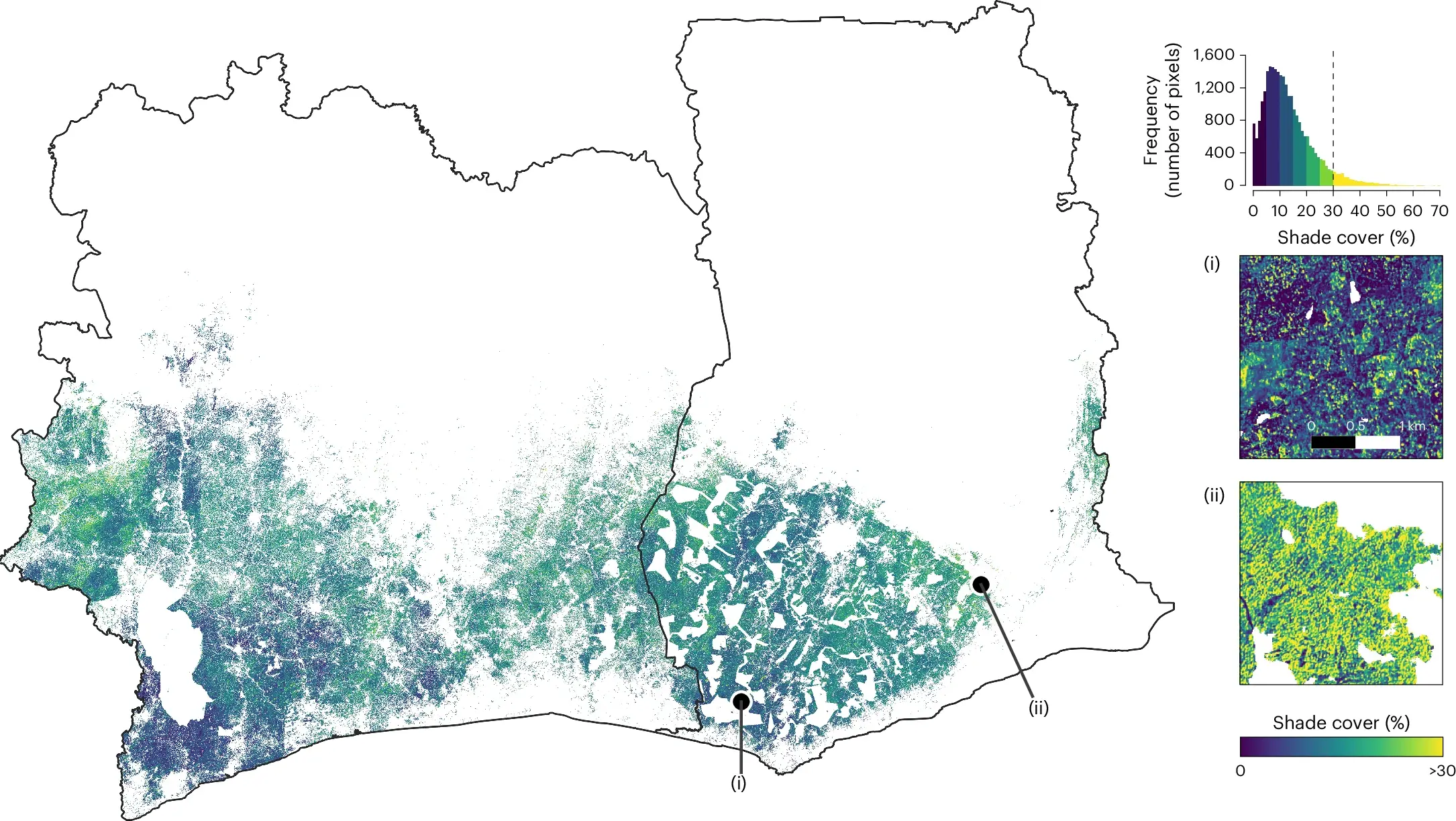
The map reveals that cocoa production is “overwhelmingly dominated by full-sun monocultures and low shade-agroforestry”, the study says.
Using satellite data, global maps of tree canopy height and on-ground verification, the researchers map the amount of “aboveground biomass” held by cocoa plantations.
Aboveground biomass comprises all living vegetation that lies above the soil – trees, leaves and other plant matter.
The map below shows the amount of aboveground biomass in both countries. The areas in yellow are those with the highest biomass and, therefore, more stored carbon.
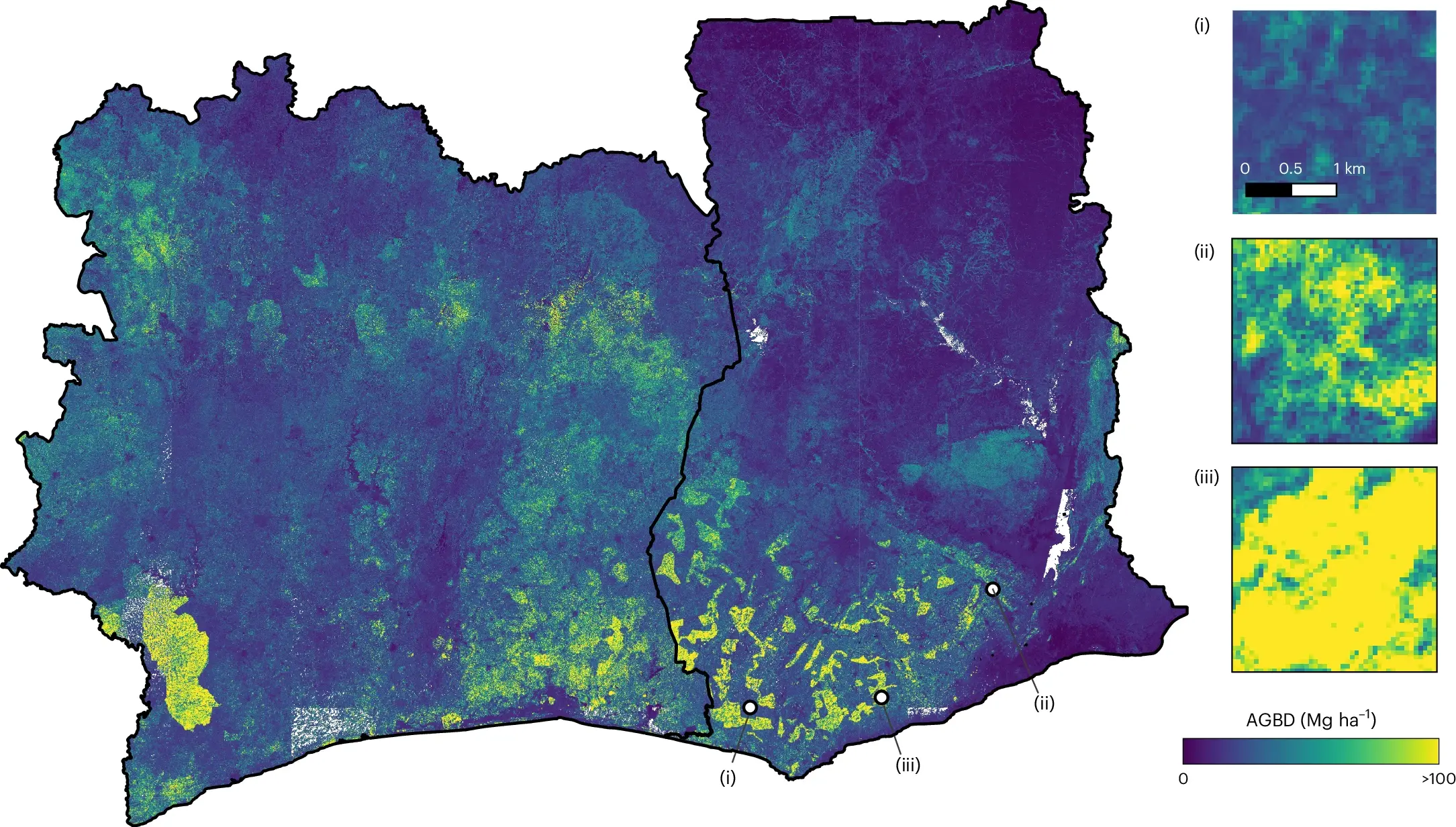
The authors project that if all cocoa plantations increased their cover of shade trees to at least 30%, the additional, taller trees could sequester an “enormous” amount of carbon – 307m tonnes of CO2e (MtCO2e) – enough to fully counterbalance the current cocoa-related emissions in both countries, without reducing production.
Blaser Hart tells Carbon Brief:
“Cocoa itself is a small tree. [It] can grow up to about eight metres tall, so it also sequesters carbon. [But] we found that tall trees that are towering high above cocoa – often timber trees – sequester much more carbon than cocoa.”
In addition, she says, the cover from large trees is “much better for cocoa” since it protects them during the hottest hours of the day, while allowing light through. They also shed large amounts of “litter”, which gets incorporated as organic matter into the soil, sequestering carbon from the atmosphere.
Barriers and limitations
The authors acknowledge several limitations to their study.
For example, they say, the analysis may underestimate the proportion of shade tree cover by excluding trees shorter than eight metres. They also note that the analysis does not consider all of the features of agroforestry systems, such as which species are planted.
Kayeli Laurence is a PhD student of landscape ecology at Jean Lorougnon Guédé University in Ivory Coast and an expert in agroforestry. The researcher, who was not involved in the study, tells Carbon Brief:
“The identified limitations call for caution, particularly when it comes to local, small-scale analyses. However, they do not undermine the general trends highlighted by the study.”
Laurence notes that the study results are consistent with other research highlighting the carbon sequestration potential of agroforestry systems. She says that the projection of carbon sequestration is “ambitious, but credible”. However, she adds:
“In practice, achieving this goal will strongly depend on local conditions: availability of species, technical support, farmers’ willingness and, above all, economic incentives.”
The study also acknowledges that smallholder farmers in west Africa “face several barriers” to adopting agroforestry, including limited incentives and insecure land tenure.
The non-profit scientific research organisation Project Drawdown notes that implementing a certain category of agroforestry called “multistrata” – a combination of long-lasting crops and multiple layers of trees or vegetation – in humid tropical climates would cost more than $1,300 per hectare.
Blaser Hart tells Carbon Brief:
“That’s a huge cost. And it’s not money that farmers have available.”
International landscape
Blaser Hart says that cocoa agroforestry provides further benefits to ecosystems, besides carbon sequestration. These include cooling the air, improving soil fertility and nutrient cycling and providing habitat for wildlife. She adds:
“We’re currently doing a big study on how agroforestry can help to provide habitat for birds. There also seems to be a bit of mammals that use cocoa agroforestry systems. In Ghana, we’re finding quite a bit of genets and civets that are in these systems. From Brazil, there’s a bit of research in the Atlantic Rainforest that shows that some monkeys use them as permanent habitat and others just as corridors to move through.”
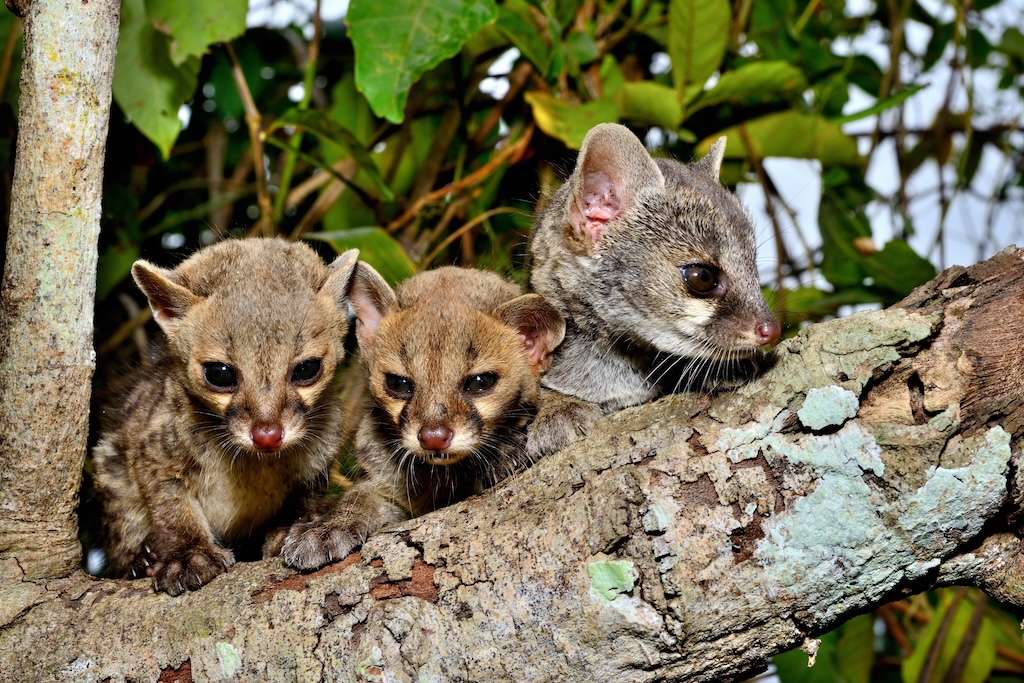
Agroforestry is included in the climate commitments of around 40% of developing countries under the Paris Agreement, according to the study.
At the corporate level, the cocoa industry has made commitments to plant “millions of shade trees in agroforests to improve the sustainability of the sector”, the study says.
Blaser Hart tells Carbon Brief that the researchers hope the work will encourage the cocoa industry to better plan its agroforestry interventions, “rather than just haphazardly handing out trees here and there”.
Laurence suggests that policymakers should improve climate finance to support farmers in transitioning to sustainable agricultural systems, while chocolate producers and certification bodies should make stronger commitments to create “real demand for sustainable cocoa produced through agroforestry”.
Ultimately, the study notes that the methods it developed to assess the status of trees in agricultural systems can be used for other commodities grown in agroforests, such as coffee.
The post Growing trees for shade has ‘enormous’ potential for cutting cocoa emissions appeared first on Carbon Brief.
Growing trees for shade has ‘enormous’ potential for cutting cocoa emissions
Greenhouse Gases
China Briefing 18 September 2025: MEE on the move; AI and energy; BRICS and climate
Welcome to Carbon Brief’s China Briefing.
China Briefing handpicks and explains the most important climate and energy stories from China over the past fortnight. Subscribe for free here.
Key developments
Huang reported to lawmakers on climate action
NPCSC REPORT: Huang Runqiu, head of the Ministry of Ecology and Environment, told Chinese lawmakers that managing the country’s carbon dioxide (CO2) intensity has become “more challenging” due to the effects of the Covid-19 pandemic, extreme weather and growing trade tensions, Bloomberg reported. According to the full text of Huang’s remarks, made during a report to the National People’s Congress (NPC) Standing Committee, the minister remarked that China’s progress on meeting the target is “broadly in line” with its current international climate pledge for 2030. [Its CO2 intensity target for 2025 is likely to be missed.] He added that challenges have worsened around balancing climate action with economic development, managing “overall and local interests” and “aligning short-term with medium-to-long-term goals”.
TARGETS ‘SURPASSED’: Huang also highlighted the progress China had made in other areas, having “already surpassed” targets for wind and solar power capacity additions and new forest stock volume, the state-run newspaper China Daily said. According to current affairs outlet China News, Huang also noted that China has continued its “efforts to enhance the clean and efficient utilisation of fossil fuels”, including “reforms” for coal-fired power plants and “steadily increasing” gas production and utilisation.

GLOBAL INFLUENCE: China is “making important contributions to the implementation of the Paris Agreement”, Huang also said, according to the full text of his remarks, having “driven substantial reductions in the costs of wind and solar power” and “advanced international cooperation on climate change”, such as in south-south collaboration. He noted that in the face of “uncertainties”, such as the US withdrawal from the Paris Agreement and the expansion of the EU’s carbon border adjustment mechanism, China will enhance its “influence, guidance and shaping power in global climate governance”.
Movements ahead of UNGA
COP30 SIGNALS: Former climate envoy Xie Zhenhua travelled with Huang to Brussels to meet EU climate lead Teresa Ribera on 16 September, Reuters reported, in order to restart “climate negotiations” ahead of the UN general assembly and COP30. It added that current climate envoy Liu Zhenmin was not expected to be present. (A photo posted on Bluesky confirmed Xie’s presence in the city.) A few days earlier, COP30 executive director Ana Toni met Huang in Beijing, where he told her that China will support Brazil in hosting a COP that “sends a strong signal” about the importance of the Paris Agreement, climate news outlet Tanpaifang reported. Toni told reporters that Brazil expects a “huge Chinese delegation” at COP, the Global Times said. She also spoke at an event at Tsinghua University attended by Xie and followed online by Carbon Brief.
UK-CHINA: Meanwhile, the UK and China established a new industrial decarbonisation working group, according to a UK government statement, focusing on areas including carbon capture, utilisation and storage. Daniel Brooker, the head of the China office at UK Research and Innovation, told finance news outlet Yicai that climate cooperation with China is “one of our immediate priorities”.
INTERCONNECTED WORLD: Separately, vice-president Han Zheng used a conference speech to urge other countries to cooperate on developing “renewable energy generation, grid interconnectivity and smart energy systems” as a way of advancing the global energy transition, according to the Communist party-affiliated newspaper People’s Daily.
First auction under new renewable pricing system
LOWER PRICES: Shandong province held the country’s first renewable power auction, following the launch of new rules for the pricing of wind and solar power, industry news outlet BJX News reported, with the auction price of wind power set at 0.319 yuan per kilowatt-hour (yuan/kWh) and those for solar set at 0.225 yuan/kWh. The low prices set by the “bellwether” province signalled that “renewables prices [across China] in the future will be lower than under the previous system”, Reuters said, adding that it could “discourage” further investment. On LinkedIn, David Fishman, principal at the Lantau Group, said that while the wind power prices would likely be acceptable for developers, the solar prices would be “very tough”, citing one as saying they would likely “abandon” all future projects in the province.
-
Sign up to Carbon Brief’s free “China Briefing” email newsletter. All you need to know about the latest developments relating to China and climate change. Sent to your inbox every Thursday.
PLANS ‘PROMPT’: Meanwhile, the National Energy Administration (NEA) urged local governments during a video conference to “promptly” release their plans for implementing the pricing reforms, energy news outlet International Energy Net said, to “stabilise” industry expectations. Separately, the NEA revealed during the conference that, between January and July 2025, China’s installed renewable energy capacity grew by 283 gigawatts (GW) to 2,171GW, current affairs outlet China News reported. In August, BJX News said, thermal-power generation grew by 1.7% – slower than July’s growth rate – while wind power grew by just over 20%, solar grew by 16% and hydropower fell by 10%.
LOCALISED PROJECTS: The NEA also co-released a notice on “improving pricing mechanisms” for localised new-energy projects, International Energy Net reported, referring to projects that “both generate and consume electricity” such as zero-carbon industrial parks. The notice outlined benchmarks for how much of their own renewable energy such projects should sell and consume, clarifying that such projects should “bear transmission and distribution fees, system operation costs and other expenses”, it added.
China set targets for new AI energy projects
AI PILOTS: China plans to increase the use of AI in the country’s energy sector, state news agency Xinhua reported, in order to “enhance energy security, improve operational efficiency and support the country’s green and low-carbon transition”. China will “promote the deep application of at least five specialised large models”, which could be used in the power grid, power generation, coal, oil, gas or other areas, according to industry news outlet China Energy News. It also reported that China plans to identify ten or more “replicable, scalable and competitive” pilot projects. Consulting firm Trivium China wrote in a note that the plan “positions AI as an indispensable tool” on climate change.
DOUBLING STORAGE: China aims to “almost double” new-energy storage capacity by 2027 to 180GW, according to a new industry plan, Reuters reported. Lithium-ion battery storage is likely to comprise the bulk of new additions, economic news outlet Jiemian said. Meanwhile, according to a new government action plan for 2025-2026, new-energy power equipment companies are expected to achieve “steady” annual revenue increase, while traditional power equipment firms should aim to grow “approximately 6%” and “leading” companies by 10%, Xinhua said.
POLICY WATCH: China adopted the atomic energy law, its first foundational law for the nuclear sector, Jiemian reported. China’s environmental code – also the first of its kind – remains under discussion, according to China News. Elsewhere, the country updated its plan to “advance the three-north shelterbelt forest programme”, China Daily said. The National Development and Reform Commission called for “exploring” pathways for real estate investment trusts to invest in ultra-high voltage transmission projects, BJX News reported. BJX News also covered new guidance on improving electricity spot markets.
Spotlight
Q&A: Will China and the BRICS fill the ‘leadership gap’ on climate change?
Amid a rapidly fracturing geopolitical order, there have been growing calls for China to “step into [the] leadership gap” left by the US on climate change.
One platform that it could use to do so is BRICS, an increasingly influential and assertive group that includes COP30 host Brazil.
In this issue, Carbon Brief explores whether or not China, alongside the BRICS, could become climate leaders. The full article is available on Carbon Brief’s website.
The BRICS group represents a number of emerging economies that aim to “increas[e] the influence of global south countries in international governance”.
Active full members include founding members Brazil, Russia, India and China, as well as South Africa, Egypt, the United Arab Emirates, Ethiopia, Indonesia and Iran.
Together, they represent 27% of global gross domestic product, 49% of the world’s population and 52% of carbon dioxide emissions, according to Carbon Brief calculations.
Four of the members – Brazil, China, India and South Africa – also form the BASIC bloc, a group with a significant voice at UN climate summits and other negotiations.
How do the BRICS approach climate change?
Lucas Carlos Lima, professor of international law at the Federal University of Minas Gerais in Brazil, wrote that recent joint statements show the BRICS had “placed climate change squarely at the centre of the bloc’s agenda”.
In July, the BRICS summit resulted in a joint declaration demanding that “accessible, timely and affordable climate finance” is provided to developing countries.
The statement also highlighted the nations’ “resolve to remain united in the pursuit of the purpose and goals of the Paris Agreement”.
However, the BRICS leaders’ declaration also “acknowledge[s] fossil fuels will still play an important role in the world’s energy mix”.
The inclusion of this language “undermin[es] the positives” of the bloc’s other statements on climate action, according to a response from Jacobo Ocharan, head of political strategies at Climate Action Network International.
What is the role of fossil fuels in the BRICS?
Many BRICS nations remain heavily reliant on fossil fuels, both for electricity generation and to support their wider energy systems.
However, this picture is starting to shift, with almost all BRICS members having adopted net-zero targets ranging from 2050 to 2070.
More tangibly, the addition of new clean-power projects means that fossil-fueled electricity generating capacity now makes up less than half of the installed total in the BRICS group as a whole in 2024, as shown in the figure below.
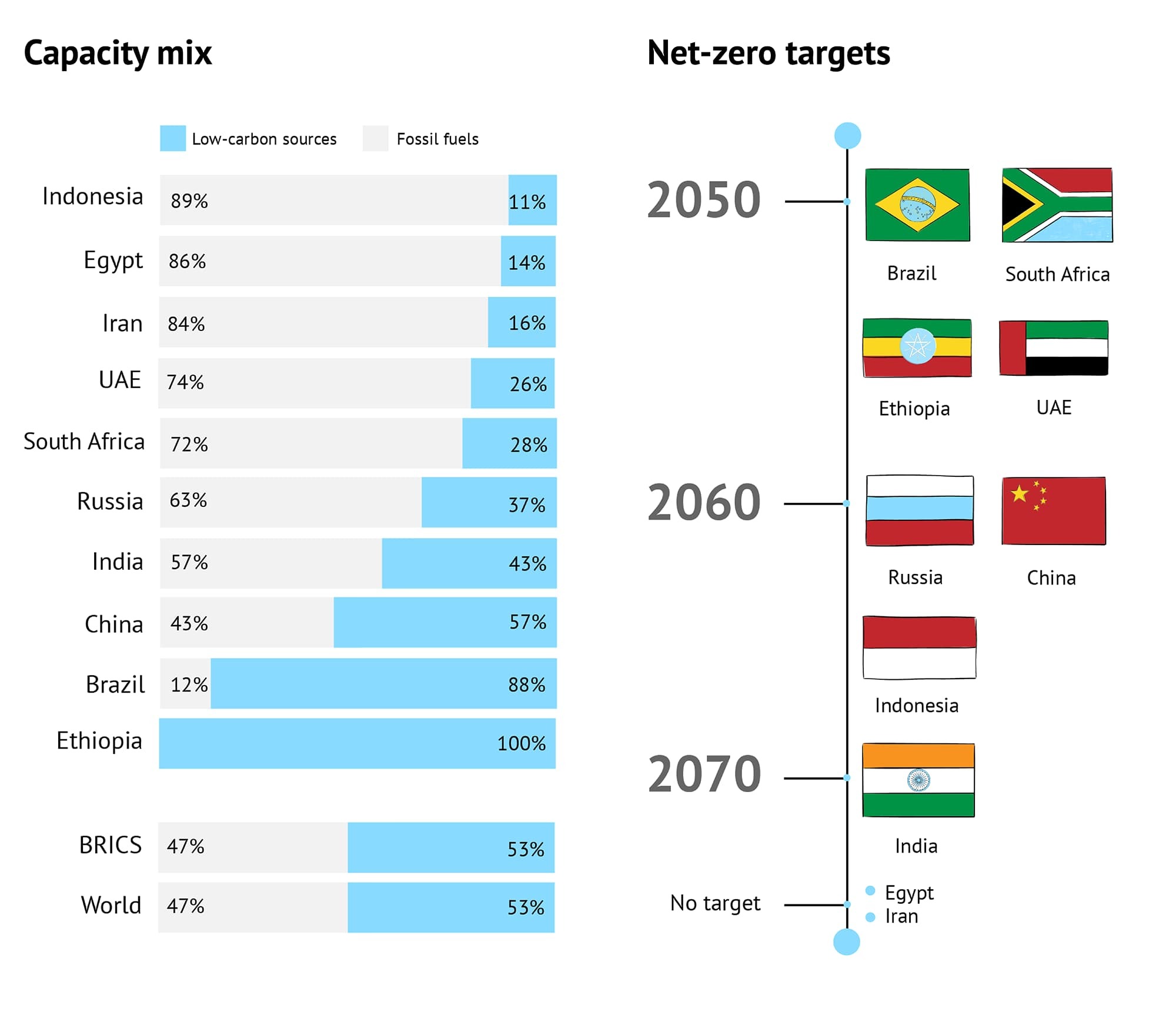
Non-fossil power, driven by “unprecedented” renewable energy growth in China, India and Brazil, accounted for 53% of the installed electricity generating capacity in BRICS countries in 2024, according to thinktank Global Energy Monitor (GEM).
Continued BRICS focus on clean energy makes it “unlikely that fossil capacity will overtake non-fossil again”, James Norman, research analyst at GEM, told Carbon Brief.
Several BRICS members, including Russia, the UAE, Iran and Indonesia, are nevertheless leading producers and exporters of fossil fuels.
China and India, meanwhile, are by some distance the world’s largest and second-largest coal users, respectively.
Nevertheless, in the short term, this might not affect the BRICS group’s climate ambition overall.
Russia does not seem to be “blocking” the “solid outcomes” of recent BRICS climate negotiations, said Kate Logan, director of the China climate hub and climate diplomacy at the Asia Society Policy Institute (ASPI).
Will China and the BRICS emerge as climate leaders?
With the withdrawal of the US from the Paris Agreement under the Trump administration, there have been increasing calls for China to take up the mantle of climate leadership.
China, at least publicly, is eschewing these calls, but does seem to be open to agreeing to “demonstrate leadership” in tandem with others, as seen in an EU-China joint statement on climate change published in late July.
Many are watching for signs of whether China’s upcoming international climate pledge, which may be published next week, will contain ambitious targets that will encourage greater global ambition.
Beatriz Mattos, research coordinator at Brazil-based climate-research institute Plataforma CIPÓ, tells Carbon Brief that China’s position as a “major investor in the renewable energy sector” means there is “enormous potential” for both it and the BRICS to assume a climate leadership role.
Watch, read, listen
NEW PARTNERS: The China-Global South Podcast examined the “stunning 113% jump” in Chinese investment into Brazil, a significant share of which was in oil and renewable energy.
PEAK ESTIMATE: A new report by Greenpeace East Asia found that China could “peak its power emissions in 2025”, at just over 5bn tonnes.
INSIDER VOICES: Three leading experts on China’s energy transition shared their insights in an event broadcasted by the Center for China and Globalization.
RESHAPING ENERGY: Ember published a “comprehensive review” of China’s energy transition and how it is “transforming global energy realities”.
$210 billion
The amount of foreign investment pledged by Chinese clean-energy technology manufacturers since 2022, according to a new report by the Net Zero Industrial Policy Lab covered by Bloomberg.
New science
Agricultural and Forest Meteorology
A new study examined the combined role of “forest activities and fire disturbance” (FAFD) on the effectiveness of China’s carbon sinks. It estimated that, between 1986 and 2020, the carbon emissions resulting from harvesting forests and forest fires offset around 54% of the carbon sequestration occurring through forestation. These findings, the authors said, “highlight the importance of accounting for carbon emissions from deforestation and forest fire when aiming to maximise carbon sequestration through forestation”.
Temperature extremes in early life and human capital: evidence from China’s labour market
Climatic Change
“Early-life exposure” to both extreme heat and extreme cold has “significant and persistent negative effects on adult labour income”, new research has found. The study, which draws from a dataset of more than one million individuals from China, said that, under a scenario with moderate warming (SSP2-4.5), average labour-income loss across China could total 0.77%, with the provinces of Qinghai, Henan, Fujian and Gansu most severely affected. It added that the impact of extreme heat on foetuses is “particularly pronounced”, with significant implications for future earnings.
China Briefing is compiled by Wanyuan Song and Anika Patel. It is edited by Wanyuan Song and Dr Simon Evans. Please send tips and feedback to china@carbonbrief.org
The post China Briefing 18 September 2025: MEE on the move; AI and energy; BRICS and climate appeared first on Carbon Brief.
China Briefing 18 September 2025: MEE on the move; AI and energy; BRICS and climate
Greenhouse Gases
Q&A: Will China and the BRICS fill the ‘leadership gap’ on climate change?
Amid a rapidly fracturing geopolitical order, there have been growing calls for China to “step into [the] leadership gap” left by the US on climate change.
While China has resisted such suggestions – at least officially – it has spent much of the past 12 months nurturing its international status as a partner for other countries, in areas ranging from the economy and global governance through to climate change.
President Xi Jinping has maintained a schedule packed with foreign-policy engagements, meeting with world leaders from Russia and India through to the EU.
Moreover, this April he made his first international climate speech since 2021, while attending a meeting on climate and the just transition hosted by Brazil.
As well as underscoring his nation’s ongoing commitment to climate action, Xi’s presence also hinted at the growing coordination between China and Brazil in this area.
More broadly, there is growing recognition of greater alignment between non-western countries – particularly in the global south – in the face of more aggressive US foreign policy.
Analysts note that pressure from the US could push groups such as the BRICS – of which Brazil and China are two founding members, alongside Russia and India – to become more cohesive and develop more concrete cooperation channels.
In a recent interview with Carbon Brief, UK climate envoy Rachel Kyte said that the “world is changing”, becoming “flatter” and that the BRICS – which now includes 11 countries, including South Africa, Egypt and Indonesia – are “more and more important”.
This Q&A explores the membership, climate stance and energy sectors of the BRICS nations, as well as the potential for China and the bloc to lead on climate change.
- What is the BRICS group?
- How do the BRICS approach climate change?
- Are Brazil and China in the BRICS ‘driving seat’?
- What is the role of fossil fuels in the BRICS?
- What is the economic impact of clean-tech?
- Will China and the BRICS emerge as climate leaders?
What is the BRICS group?
The BRICS group represents a number of emerging economies that aim to “strengthen” cooperation amongst themselves and to “increas[e] the influence of global south countries in international governance”.
They coordinate on a range of topics, from international finance to climate diplomacy.
It was founded by Brazil, Russia, India and China – hence, the original name “BRIC” – which later became “BRICS” with the inclusion of South Africa. More recently, it expanded again to include Egypt, the United Arab Emirates, Ethiopia, Indonesia and Iran.
Saudi Arabia has been formally invited to join the bloc, but has not yet accepted the invitation. A number of others participate in the grouping as partner countries, including Malaysia, Thailand and Nigeria.
Together, the full members of the group represent 27% of global gross domestic product (GDP), 49% of the world’s population and 52% of emissions, according to Carbon Brief calculations illustrated below.

Four of the members – Brazil, China, India and South Africa – also form the BASIC bloc, a group with a significant voice at UN climate summits and other negotiations.
BASIC was formed in Beijing in 2009, with representatives from the four countries meeting to coordinate on climate negotiations from the standpoint of major emerging economies.
This culminated at the COP15 climate talks in Copenhagen in 2009, when the BASIC group issued a joint set of “non-negotiable terms” and went on to work directly with the US to agree the Copenhagen Accord.
The bloc has used less combative tactics in subsequent COPs, but it continues to issue joint statements on climate change and to strongly advocate for certain issues.
At both COP28 and COP29, BASIC submitted a proposal to have “unilateral trade measures related to climate change” – referring to policies such as the EU’s carbon border adjustment mechanism (CBAM) – added to the meeting agenda.
The request was denied both times.
How do the BRICS approach climate change?
Alongside BASIC, the BRICS group is also becoming increasingly focused on climate policy.
COP30 executive director Ana Toni, speaking at a September 2025 event at Tsinghua University attended online by Carbon Brief, said that BRICS countries have “realised that climate is not just a financial issue or a niche”, but rather a “pillar for prosperity, development and growth”.
Lucas Carlos Lima, professor of international law at the Federal University of Minas Gerais in Brazil, wrote in an April 2025 article for Modern Diplomacy that recent joint statements show the BRICS had “placed climate change squarely at the centre of the bloc’s agenda”.
The group has also been playing an increasingly significant role in other multilateral fora. For example, a BRICS proposal at the COP16 UN biodiversity negotiations in February formed the basis of an agreement to mobilise at least $200bn per year to protect nature.
Susana Muhamad, president of the COP16 nature talks, told Reuters in March that BRICS nations had been “bridge builders” in the negotiations.
She added:
“I understand there’s a lot of countries wanting to join BRICS, because…if you have to confront something like the US, you are not alone.”
Environment ministers of BRICS countries also recently issued a joint statement that “reaffirm[ed] our steadfast commitments” to addressing climate change, adding that BRICS “can positively contribute to…the global environmental agenda.”
Their finance ministers also agreed in May on a climate-finance framework, outlining priorities including “the reform of multilateral development banks, the scaling up of concessional finance and the mobilising of private capital to support climate efforts in the global south”.
The framework represents “common and collective BRICS action in the area of climate finance” for the first time, notes Tatiana Rosito, international affairs secretary at Brazil’s finance ministry.

The framework was adopted at the BRICS summit in July, where a number of leaders gathered to sign a joint declaration demanding that “accessible, timely and affordable climate finance” is provided to developing countries.
This, it adds, “is a responsibility of developed countries” under the Paris Agreement.
The statement also highlighted the nations’ “resolve to remain united in the pursuit of the purpose and goals of the Paris Agreement”, featuring 21 paragraphs in a section on climate change spanning just transitions, carbon markets and critical minerals.
“It is encouraging that BRICS nations called for more climate lending, deeper green bond markets and better carbon accounting,” Mirela Sandrini, interim executive director for Brazil at the World Resources Institute, said in a statement. She added:
“South-south collaboration of this scale and ambition can inject much-needed momentum into international climate diplomacy ahead of COP30.”
However, the BRICS leaders’ declaration also “acknowledge[s] fossil fuels will still play an important role in the world’s energy mix, particularly for emerging markets and developing economies”.
The inclusion of this language “undermin[es] the positives” of the bloc’s other statements on climate action, according to a response from Jacobo Ocharan, head of political strategies at Climate Action Network International.
Manuel Pulgar-Vidal, global climate and energy lead at WWF, agrees, saying climate change is “treated as background noise” in the joint statement, with “no clear articulation of the BRICS+ role in the global climate response”.
Are Brazil and China in the BRICS ‘driving seat’?
Much of the recent BRICS focus on climate change is due to Brazil being “in the driver’s seat”, says Kate Logan, director of the China climate hub and climate diplomacy at the Asia Society Policy Institute (ASPI), speaking to Carbon Brief.
As well as hosting COP30, Brazil recently chaired the G20 and is currently presiding over the BRICS. It used both of these forums to prioritise climate action on the agenda, she adds.
There has been frequent coordination between COP30, Brazilian and Chinese officials in the run-up to the conference.
This included a meeting of BRICS environment ministers held in April 2025, a separate April meeting between COP30 president André Corrêa do Lago and Chinese minister for the environment and ecology Huang Runqiu, as well as an earlier meeting in March between Huang and UN climate chief Simon Stiell.
Most significantly, Chinese president Xi Jinping appeared at a closed-door April 2025 meeting of global leaders organised by the UN and Brazil, telling his audience that “China’s actions to address climate change will not slow down”.
Many analysts saw the statement as a clear signal of China’s support for multilateralism, in sharp contrast to the US withdrawing from climate negotiations.
Xi’s participation in the meeting also underscored growing solidarity between China and Brazil on accelerating climate action.
Brazil and China have a long history of cooperation on environmental issues, including through the China-Brazil High-Level Coordination and Cooperation Commission (COSBAN).
The Brazilian government describes COSBAN as the “highest-level governmental mechanism” between the two countries. It includes tracks specifically focused on energy, agriculture and mining, as well as the environment and climate change.
But there has been a notable uptick in engagement under the new Lula administration.
For the current Brazilian administration, China is an “essential partner in global climate solutions”, according to a briefing note published by the Brazilian climate network Observatório do Clima.
A related opinion article in Brazilian newspaper Folha de S. Paolo, written by Stela Herschmann, climate policy specialist at the Observatório do Clima, and Beibei Yin, founder of environmental consultancy Bambu Consulting, argues that China and Brazil could form the “new G2” – the moniker given to the US-China alignment that they say shaped global climate policy for “more than two decades”.
They add that Brazil, through its unique role in the world and current position, can help “fill the current vacuum” of climate leadership. They write:
“Brazil enjoys the respect of the international community because it often mediates the divisions between developed and developing countries in climate negotiations…The presidency of COP30 and BRICS adds to this, making the country a natural candidate to fill the current vacuum of climate leadership.”
However, the two countries’ climate approaches have diverged at times.
Jennifer Allan, senior lecturer in international relations at Cardiff University, tells Carbon Brief: “These countries have several similar views, but also have diverged in the past.”
For example, she says, Brazil’s suggestion at COP26 of a “concentric” approach to cutting emissions, with emerging economies offering more stringent targets than other developing countries, was opposed by China, which wanted to “maintain the firewall” between developed and developing countries.
What is the role of fossil fuels in the BRICS?
Many BRICS nations remain heavily reliant on fossil fuels, both for electricity generation and to support their wider energy systems.
However, this picture is starting to shift, with almost all BRICS members having adopted net-zero targets ranging from 2050 for Brazil, South Africa and others, through to 2060 for China and Russia, or 2070 for India.
More tangibly, the addition of new clean-power projects means that fossil-fueled electricity generating capacity now makes up less than half of the installed total in the BRICS group as a whole in 2024, as shown in the figure below.
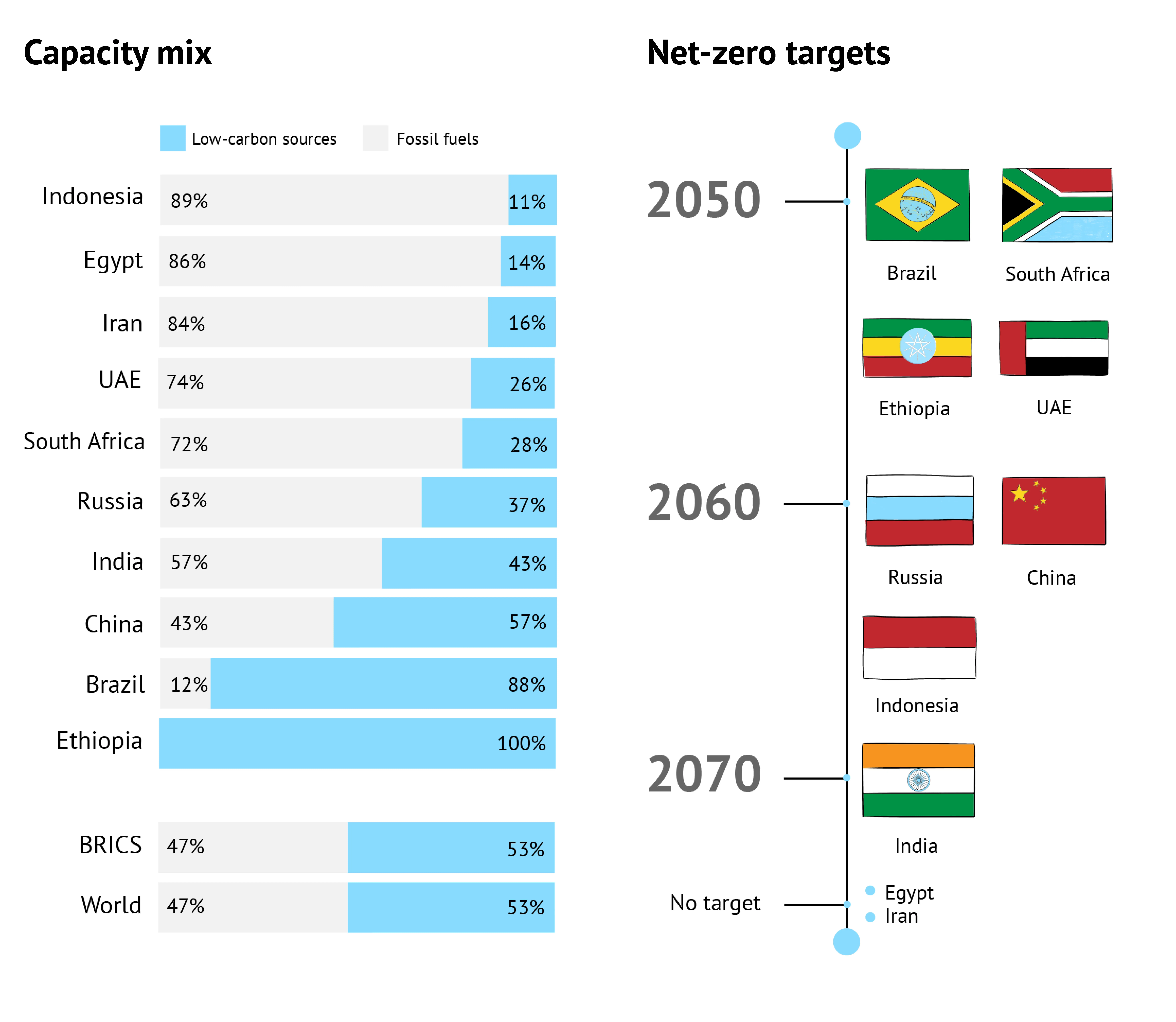
Non-fossil power, driven by “unprecedented” renewable energy growth in China, India and Brazil, accounted for 53% of the installed electricity generating capacity in BRICS countries overall in 2024, according to recent analysis by the thinktank Global Energy Monitor (GEM). This puts them in line with the global average.
Ethiopia, Brazil and China boast higher-than-average shares of clean capacity – at 100%, 88% and 57% respectively. India’s clean-capacity share stands at 43%.
Continued BRICS focus on clean energy makes it “unlikely that fossil capacity will overtake non-fossil again”, James Norman, research analyst at GEM, tells Carbon Brief, adding that much of this is driven by significant renewable additions in some members, particularly China.
While some BRICS members are continuing to commission “significant amounts of new coal-fired capacity”, he says, it remains uncertain whether these new plants will be completed, or if they will go on to operate at full capacity.
Several BRICS members are also leading producers and exporters of fossil fuels. Russia is a major exporter of all types of fossil fuels, the Statistical Review of World Energy shows, while the UAE, Iran and Indonesia have large oil- or coal-exporting industries.
The data shows that China and India, meanwhile, are by some distance the world’s largest and second-largest coal users, respectively, predominantly fueled by domestic mining. China alone accounts for more than half of global coal production and use.
Norman acknowledges that “fossil dominance remains largely unchanged” among some BRICS members.
He states that countries such as Iran, with “entrenched modes of power production”, or with “limited strategic interest in overhauling the energy sector, such as Russia”, are on a different trajectory to countries such as Brazil or China.
Nevertheless, he says, the “strong economic case for solar and wind”, as well as the fact that nearly all BRICS countries have announced renewable energy targets, “makes continued growth in clean energy across the group highly likely”.
In the short term, meanwhile, the continued reliance of some members on fossil fuels might not lessen the BRICS group’s climate ambition overall. It is “notable” that Russia does not seem to be “blocking” the “solid outcomes” of recent BRICS climate negotiations, Logan tells Carbon Brief.
Indeed, the 2024 Kazan declaration, which featured a lengthy and detailed section on climate change, was released under the Russian BRICS presidency.
Still, the group is not a united front in all areas, for example the rivalry between China and India. Tensions remain high between the two countries on a number of issues, from border disputes to supply chains and geopolitical alliances.
This has spilled into climate-related topics, with India complaining about China’s construction of mega-dams in the Himalayas and launching anti-dumping investigations into solar imports from China.
At COP29, China and India at times took up conflicting stances during negotiations – most notably during the final stages of the climate finance deal, where China “helped prevent” efforts by India to block the deal, Logan wrote in an analysis for Dialogue Earth.
Another area of contention for India at COP29 was CBAM, which it said contributed to a “very, very competitive, hostile environment” that made it “difficult” to enable an energy transition.
By contrast, Logan tells Carbon Brief, China is “much less worried” about CBAM.
(Brazil, too, is unlikely to push hard to include CBAM and other “unilateral” trade measures in the COP30 agenda, Allan says, in order to maintain its “neutral” position as the holder of the COP presidency and the trust of other parties. Indeed, it is reportedly pushing for this issue to be taken up in a new forum, completely outside the climate talks.)
Nevertheless, India and China are united in climate negotiations by their commitment to ensuring all agreements uphold the principle of common but differentiated responsibilities and respective capabilities (CBDR-RC).
“This is something [in which] they’ll continue to be aligned”, Logan says, “but how it plays out in practice is where you start to see divergences”.
A recent rapprochement in China-India relations saw Indian prime minister Narendra Modi visit China for the first time in seven years.
The two countries also came together at the International Maritime Organization, where they successfully pushed for publicly-available data on shipping emissions to be anonymised.
Earlier, Brazil, China, South Africa and several other developing countries also lobbied against the creation of a global levy on shipping emissions.
Allen notes that whether or not BRICS and BASIC can align on climate may, ultimately, be a moot point, given that BASIC is just one of several coalitions that China operates in and that it is currently “less active” than other coalitions.
For example, she says, unlike the Like-Minded Developing Countries (LMDC) group, BASIC “doesn’t negotiate as a group in contact groups” at the UN climate talks. She adds:
“Multiple coalitions are a way for [a country] to multipl[y] their influence, while also perhaps hiding its individual views among those of the group.”
What is the economic impact of clean-tech?
Beyond the realms of climate diplomacy, it is increasingly clear that there is a hard-nosed economic reality to the positions being taken by China and other BRICS nations.
Indeed, as China works with Brazil and the BRICS to centre emerging markets’ concerns in climate policy, it also plays a key role in the economics of the energy transition.
The country accounts for more than 80% of global solar manufacturing, more than 70% of electric vehicle production and more than 75% of battery production.
While most of this is consumed domestically, exports of each of these categories – which it often calls the “new-three” – are “booming”, finance news outlet Caixin reports.
Historically these exports would have been destined for developed countries. But, in 2024, “half of all China’s exports of solar and wind power equipment and electric vehicles (EVs) [went] to the global south”, Lauri Myllyvirta and Hubert Thieriot, lead analyst and data lead at the Centre for Research on Energy and Clean Air (CREA), write at Dialogue Earth.
Separate analysis by Myllyvirta for Carbon Brief revealed that China’s exports of clean-energy technologies in 2024 alone will reduce emissions in the rest of the world by 1%, avoiding some 4bn tonnes of carbon dioxide (CO2 over their lifetimes).
Moreover, clean-energy industries accounted for more than 10% of China’s GDP in 2024 for the first time ever, driving a quarter of economic growth that year.
Meanwhile, Chinese lending overseas is also increasingly focused on low-carbon infrastructure, according to the Boston University Global Development Policy Center.
Their analysis finds that the “share of renewable energy in China’s portfolio has increased significantly”, with solar and wind projects “dominat[ing]” the types of projects funded in 2022 and 2023.
This stands in sharp contrast to typical Chinese lending activity before 2021, which showed a preference for conventional power projects, such as coal and hydropower.
According to Myllyvirta and Thieriot, the “important role that clean-energy technology plays in the country’s economy and exports” will encourage China to ensure that the global energy transition “keeps accelerating”.
They add: “That will be seen in bilateral lending and diplomacy, and could also lead the country to take more forward-leaning positions in multilateral climate negotiations.”
Will China and the BRICS emerge as climate leaders?
With the withdrawal of the US from the Paris Agreement under the Trump administration, there have been increasing calls for China to take up the mantle of climate leadership.
Many are watching for signs of whether China’s upcoming international climate pledge, which may be published by the UN general assembly meeting next week, will contain ambitious targets that will encourage greater global ambition.
Beatriz Mattos, research coordinator at Brazil-based climate-research institute Plataforma CIPÓ, tells Carbon Brief that China’s position as a “major investor in the renewable energy sector” means there is “enormous potential” for both it and the BRICS to assume a climate leadership role.
China, at least publicly, is eschewing these calls. In an interview with state-owned magazine China Newsweek, climate envoy Liu Zhenmin said in response to a question about China’s climate leadership that the calls are just “the west giving us a ‘tall hat’” – an expression meaning trying to flatter China. He added:
“Of course, within their respective camps, major countries should play a more leading role, such as the EU and US in the developed countries camp, and the BASIC countries in the developing countries camp. But BASIC cannot be a substitute for all developing countries, and developing countries will still participate in [climate] negotiations within the framework of ‘G77+China’. This is the basis for cooperation in the global south.”
Notably, this does not seem to preclude China from agreeing to “demonstrate leadership” in tandem with others, as seen in an EU-China joint statement on climate change published in late July.
BASIC is “important for China in climate negotiations given the influence of other large emerging economies”, Yixian Sun, associate professor in international development at the University of Bath, tells Carbon Brief.
“On many issues (especially sensitive issues regarding its developing country status), China doesn’t want to stand out by itself,” he says, with the grouping providing cover in negotiations.
Mattos agrees, stating that “remaining part of this group serves as a way [for China] to reinforce its identity as a developing country in climate negotiations”.
More broadly, it will likely continue to align with the other BRICS nations, when this offers a way to advance its positions in climate negotiations.
Sun expects Brazil and China to sustain their elevated levels of climate cooperation even after Brazil hands over the COP presidency, based on their 2023 joint statement. However, he says there are still questions around what new bilateral climate initiatives would look like and how “concrete” they would be in practice.
Looking ahead, Logan notes, BRICS could also be in a position to sustain its influence if India hosts COP33 in 2028.
“BRICS has in multiple documents endorsed India’s bid for COP33”, she says, which, given India’s presidency of BRICS in 2026, could allow Brazil and China to “influence India in a more constructive direction” on climate, over a number of years.
The post Q&A: Will China and the BRICS fill the ‘leadership gap’ on climate change? appeared first on Carbon Brief.
Q&A: Will China and the BRICS fill the ‘leadership gap’ on climate change?
-
Climate Change2 years ago
Spanish-language misinformation on renewable energy spreads online, report shows
-
Climate Change Videos2 years ago
The toxic gas flares fuelling Nigeria’s climate change – BBC News
-

 Greenhouse Gases1 year ago
Greenhouse Gases1 year ago嘉宾来稿:满足中国增长的用电需求 光伏加储能“比新建煤电更实惠”
-

 Climate Change1 year ago
Climate Change1 year ago嘉宾来稿:满足中国增长的用电需求 光伏加储能“比新建煤电更实惠”
-

 Carbon Footprint1 year ago
Carbon Footprint1 year agoUS SEC’s Climate Disclosure Rules Spur Renewed Interest in Carbon Credits
-
Climate Change1 month ago
Guest post: Why China is still building new coal – and when it might stop
-
Climate Change2 years ago
Why airlines are perfect targets for anti-greenwashing legal action
-
Renewable Energy2 months ago
US Grid Strain, Possible Allete Sale





